- Home
- Barbara Kingsolver
High Tide in Tucson Page 7
High Tide in Tucson Read online
Page 7
I've heard it many times. Not lately--it's been years, in fact, since Devils or Wildcats or Buffalo Bills or anything in tight pants and a helmet came into my house, because no one here is that interested. We tend to hold with Lorena Hickok, a columnist in the 1920s for the Minneapolis Morning Tribune, who observed of college football that "you might just as well put in your time watching a lot of ants running in and out of their hole. That is, if there isn't anything else you'd rather be doing right then." I'm sorry if I'm tipping sacred cows here. I don't mean to say I'm above watching organized sports. Possibly below it, for the fact is I'd rather watch ants. Draw your own conclusions.
But I am interested in sports as a concept, especially where it serves, like religion, as a touchstone for essential human longings. The entitlement to root for a different team each week is a little baffling, when held against other things we're supposed to take as self-evident. Love is eternal, isn't it? What is this slippery business, this hierarchy of shifting loyalties that glide in and out of place as methodically as the gears on a racing bike taking a hill? At first I suspected this creative fudge of allegiance had something to do with gender. I figured it was just one more, of those mysteries withheld from women but revealed to men in their tender boyhoods, along with oil level vs. oil pressure, and how to believe you still look fine in a swimsuit once you've acquired love handles.
Determined to get to the bottom of it, I phoned a friend who has season tickets and wouldn't for love nor money miss an Arizona Wildcats game. And who is female. "Oh, no, I'd never root for the Sun Devils," she said without hesitation. "As far as I'm concerned it's Arizona or nobody."
Why? It's personal, she explained. After watching those six-foot-ten-and-still-growing boys play ball every Thursday night, you feel you know them. It's like they're your kids.
My friend paused; her tone was not all that maternal. "And let's face it," she added, "they've got great buns."
She allowed that her husband didn't share this outlook. "Oh, sure, he roots for other PAC 10 teams when they're not playing the Wildcats," she told me with a hint of scorn. "He'll root for anybody."
What is loyalty worth, if it's situational? This trend I was uncovering among certain sports fans reminded me of the song that suggests, if you can't be with your sweetie, you should love the sweetie who's handy. Whatever happened to "I'd rather be blue over you than happy with somebody new?"
Unquestionably, things like loyalty and territorial attachment are situational, from Candlestick Park to the Halls of Montezuma and in places far more ordinary. Even a dog, whose species has cornered the loyalty market, will show this weakness. I used to have one like that. She was a shepherd mongrel with a wild hair, half coyote. Her coyote instincts served her well for a good lifetime, steering her clear of what Darwin thought of as "nature red in tooth and claw" (though it was Tennyson who put it that way; Darwin couldn't have been that concise if his life depended on it). Out here in the desert, "tooth and claw" means prickly-pear spine and rattlesnake fang. My dog Jessie would often run congenially with small packs of coyotes, until she came within a stone's throw of the house. Then, brought up short against the sight of which side her bread was buttered on--which is to say, me--she would whirl around and make a big show of chasing her erstwhile friends out of the territory. I watched this happen dozens of times. One could argue conflicting genetic paradigms, or one could argue dog chow. Either way, Fido is an infidel.
It could be worse. Years ago as a graduate student I helped do a study of desert pupfish--a small, unglamorous species whose mating behavior is so opportunistic it would make Lolita blush. Pupfish live in ephemeral streams where populations fluctuate fairly drastically. When females are scarce, the male will hunt down a mate and swim faithfully by her side, for richer or for poorer, monogamous as Bob Cratchit. But when the tide turns and there's a surplus of females, the model-husband pupfish becomes a bantam-weight macho terror. He puffs out his little blue fins and claims a patch of river bottom as his private singles scene, performing all manner of gyrations to lure in the babes, who eventually do meander in to lay their eggs. Possibly they are rolling their eyes, muttering to one another about midlife crisis and the trophy wife. Darwin was right; nature is no picnic. It's an office party.
But it's not fair to cast this as a bad-boy business; females are no consistent models of fidelity either. Female elk are known to copulate with many males in the same day--and that's hardly the worst that can happen. The hills are alive with black-widow stories. A female praying mantis rewards her husband's conjugal exertions by eating his head; basically, that is their prenuptial agreement. And octopus mating, in its own special way, eclipses the tawdrily famous Bobbitts: the male octopus does not come equipped with a penis so he's obliged to offer his girlfriend a tough little packet of sperm (some valentine, that) by grasping it in a tentacle and shoving it down her breathing siphon. She responds to his overture by attempting to rip him apart. "These matings may be so violent," writes Robert A. Wallace in a forthright account, "that if the male has managed to insert his arm into the female's siphon, it may be literally torn from his body. After such an encounter, the female can be seen swimming alone, bearing the grisly memento of a previous coupling."
In a disenchanting revision of some cherished folklore, biologists are discovering that monogamy is rarer than unicorns in the animal world. Many species touted as mating for life--swans, bluebirds, Australian fairy wrens--are turning out to be hardcore sneaks. The tools of molecular genetics, similar to the tests used in human paternity suits, have shown that in the nest of the average fairy wren, one egg in five is sired by another wren's mate. Among all songbirds that have been examined in this way, the count is closer to one in three. It turns out the bluebird of happiness wrote the book on free love.
Our culture counts fidelity as a virtue, but where reproduction is concerned, it's more of a strategy. Monogamy is most likely to be practiced by creatures who have such pathetically helpless or numerous young it takes two frazzled parents to bring them to the self-supporting stage. Think of it as Darwinian family values: if a mate abandons the family, only to leave behind starved kids and nary a gene passed on, he or she is a biological dead end. So, for species in which the parenting demand is extreme, the biological directive that survives through the generations is the gene that sings out, "Be it ever so humble, there's no place like home."
This trend, predicting less promiscuity among species with a high parenting demand, bears out pretty well. Birds have the daunting egg chore and then a shrieking brood with mouths literally bigger than their bodies, so the parents do at least put up a show of keeping to the straight and narrow. Among mammals, monogamy is almost unknown, but it's adhered to by certain mice, voles, and pigs that have altricial (meaning pink, squirmy, frightfully helpless) young. Virtually all primates are promiscuous except the few species that always bear twins. In reptiles and amphibians, whose parenting style is best described as "hit and run," mate loyalty is out of the question.
Whether or not humans spent their millions of prelegal years being faithful to one true love is anyone's guess. If you look around now, you'll find every arrangement imaginable: wives who routinely take several husbands at once in the Himalayas; the reverse in Africa and Utah; serial monogamy in Polynesia and the contemporary United States. Many societies that aspire to monogamy are blunt about the loopholes, by recognizing a type of lineage anthropologists call avuncular: a child's paternal agent is the mother's brother, since he's the closest adult male who is known, with certainty, to be the child's blood relative.
We are a tough study. It's true our young are born fragile and witless as they come. But we are long-lived, too, and have so many opportunities to rethink the mate choice. "Rethink" is an important word--maybe we've traveled far enough from our origins so that biology has little to do with our amorous destiny. The wide variety of mating strategies we adopt across different cultures would suggest anything but biological determinism. But the battle of the se
xes is such a persistent, bittersweet mystery the popular imagination seems convinced we are hard-wired for la difference. One extremely well-plowed argument goes this way: a male can increase his genes in the population by impregnating as many females as humanly possible, but it's to a female's advantage--since childbearing becomes her burden--to choose a mate who appears provident, loyal, thrifty, and inclined to stick around. So, the argument goes, men are predisposed to promiscuity, and women to being picky about their mates. Is it engraved upon us, this thing called adultery? It's an unanswerable question that seems to enthrall us no end. Physical anthropologists and sociobiologists have produced far more reams on the subject than Hugh Hefner ever did.
Sociobiology, which made a big splash in the seventies, threw some valuable light on the field of evolutionary biology, but it also threw some hooey into the kettle, where human behavior is concerned. Edward O. Wilson produced an incendiary book, On Human Nature, in which he asserted that there are biological bases for a large number (he implies, all) of the characteristics that are general enough to be called our "nature," and which we've integrated into our culture, political systems, and economy. I applaud Wilson (one of the world's preeminent biologists) for trying to bring humans back into the fold of nature. But he was roundly and rightly attacked, I think, for presuming that so much of human behavior--everything from armed combat to flirtation--is directed by our genes. In seeking biological explanations Wilson provided almost no direct evidence for genetic control (as there is almost none to be found). He relied instead on analogy and "just-so" stories, suggesting that if a behavior appears to increase our likelihood of survival in certain contexts it must be biologically programmed. He ignored other levels of pressure--the social, material, and economic contexts--that influence decision making in the enormously flexible human brain. On Human Nature tried to draw us out onto the ice-thin proposition of biology as a new code of ethics: We are what we are, not because "God made us that way," but because four million years of natural selection did. And we'd better pay attention, Wilson warned, citing as a cautionary tale an example of enforced gender equality in an Israeli kibbutz, against which women rebelled and demanded more time with their children. (He neglected to mention that in this great experiment women were encouraged to value and perform men's work, but not the reverse, so women ended up doing both.) If we wish to change society, he wrote, "we can teach and reward and coerce. But in so doing, we must consider the price...measured in time and energy required for training and enforcement and in the less tangible currency of human happiness that must be spent to circumvent our innate predispositions." As science-based ethics replace those of religion, Wilson argued, our unconscious motives will drop out, we'll know what we're really capable of, and the truth will set us free.
Oh, but Dr. Wilson, which truth? Never in the deep blue sea will we ever be that conscious of our motives. The problem with identifying the biological roots of such things as sexism, aggression, and racism is that we're looking at our past through spectacles tinted with sexism, aggression, and racism. On Human Nature devotes a full chapter to the innateness of gender roles, in which women are passive and men naturally aggressive. (Not because God made us that way, but allegedly because it helped us survive.) Wilson began developing this line of thinking in an earlier book, Sociobiology, in which he wrote, "The populace of an American industrial city, no less than a band of hunter-gatherers in the Australian desert, is organized around [the nuclear family]....During the day the women and children remain in the residential area while the men forage for game or its symbolic equivalent." He took this to be self-evident, and worked backward to construct a biological rationale for the arrangement. Stunningly, he did this in spite of the fact that in 1975, the year of the book's publication, 47 percent of all U.S. women aged sixteen and over were out working for the "symbolic equivalent," holding down two out of every five jobs.
In a similar feat of circular thinking, paleoanthropologists of the sixties and seventies presumed that human evolution was greatly influenced by pair bonding and a division of labor by gender. Evidence for this was the fact that skeletal remains of early hominids showed a marked size difference between males (larger) and females (smaller). These remains consisted only of fragments, never whole skeletons. They had been sorted into male and female with difficulty, frequently on the basis of nothing but their size!
Not only the answers we find but the very questions we ask, as scientists, are bathed in unconscious motives. The Mismeasure of Man, by Stephen Jay Gould, exposes the myriad ways science has been used throughout history to prove the superiority of Caucasian males, which happens to match the description of the scientists who did the work in question. Their work was earnest, painstaking, and dazzlingly blind to its own biases. European science of the eighteenth and nineteenth centuries presumed intelligence and human worthiness were things contained in the head, and set itself like a dog on a bone to measuring skulls. Thousands upon thousands of skulls: male and female, Caucasian and Asian, Hottentot and Huron. Skulls of professionals were pitted against those of clerks and laborers. The results are a testament to science's deep roots in creative interpretation and selective oversight: the expected winners always came out on top. The measurements were unconsciously bent, again and again, to make it so. Just as Dr. Wilson forgot to notice that half of all modern female "gatherers" were out "hunting," a nineteenth-century physician named Samuel George Morton conducted his world-renowned work on the essential character of human races without encumbering himself with contradictory evidence. Of the Greenland Eskimo he wrote, "Their mental faculties, from infancy to old age, present a continued childhood," and of the Chinese, "So versatile are their feelings and actions, that they have been compared to the monkey race, whose attention is perpetually changing from one object to another." Armed with these foregone conclusions, he compared the brain sizes of these and other races in his enormous skull collection with those of Caucasians, by filling the cranial cavities with mustard seed or lead BB shot, then pouring it back into a graduated cylinder and reading the volume. Steven Jay Gould has carefully examined Morton's data, wondering how such a respected scientist arrived at a clear ranking of skull sizes (Caucasians largest, followed by so-called Mongolians and American Indians, then Africans) that cannot now be found to exist. Gould believes Morton didn't consciously fudge his data, but did it in dozens of unconscious ways, from selectively firing his assistants to failing to notice the relationship between skull size and body size in all races, and ultimately, by looking hard for what he needed to see. "Plausible scenarios are easy to construct," Gould writes. "Morton, measuring by seed, picks up a threateningly large [African] skull, fills it lightly and gives it a few desultory shakes. Next, he takes a distressingly small Caucasian skull, shakes hard, and pushes mightily at the foramen magnum with his thumb."
It's nearly a vignette of black comedy to imagine Dr. Morton hunched over his skulls, with a racket of BB's rolling over his worktable and mustard seed crunching under his feet, as he labors to make the numbers of his science match the equations fixed in his heart. But in truth it's a horrific moment of history, for the data from his somber skullduggery were used to justify generations of genocide and slavery.
In this century, the biological determinists have laid down skulls and taken up testing. In 1912, when racism in America swelled on a rising tide of immigration, the U.S. Public Health Service hired psychologist H. H. Goddard to help screen out the imagined menace of inferior minds that were poised to contaminate the (equally imagined) pellucid American gene pool. Goddard, who invented the term "moron," created his own test for mental deficiency. Gould's Mismeasure of Man gives a remarkable account of how Goddard's test questions were fired at immigrants as they stepped bewildered and exhausted off the boat at Ellis Island. (Many had never before held a pencil, and had no possible frame of reference for understanding what was being asked of them.) Goddard arrived at these staggering results: 83 percent of Jews, 87 percent of Russians, 80 percen
t of Hungarians, and 79 percent of Italians were diagnosed as morons. At the time, no one paused to wonder how any nation could be carrying out its sundry business with four-fifths of its citizens punching in below the mental age of twelve; ethnic quotas on U.S. immigration were in place within the decade.
The explosive publication in 1994 of a book called The Bell Curve was an attempt to prove, yet again, the intellectual superiority of Caucasians. Written just in time to catch a new current of racism, the book drips with statistics and academic language, but its emotional heart seems bent on justifying the subordinate status of people of color in the U.S. Authors Richard Herrnstein and Charles Murray have made extravagant claims linking IQ and race, frequently basing them on the work of researchers who received grants from the Pioneer Fund, a bluntly pro-white organization that has long denounced school desegregation and advocated sterilization to eliminate so-called genetically unfit individuals or races from society. It's a case of science with the fingerprints of "motive" all over it.
No matter that The Bell Curve is made of very tired stuff, not much different from mismeasuring skulls; the book was taken seriously enough to capture the cover of Newsweek, tie up the headlines and news roundups, and sell like a house afire. The authors proved one thing, without a doubt: the privileged have not yet tired of hearing how righteously they came by their place at the table.
This whole line of inquiry, in which science is invoked to explain how we got where we are, is fatally tainted by what Hume called the "is-ought" problem. This is the philosophical error of confusing what exists with its right to exist, even though substance and scruples--what is and what ought--are entirely separate items, apples and oranges. When a mother says, "Boys will be boys," is she explaining her son's misbehavior, or predicting it, or forgiving it? Similarly, if we're allowed to talk on and on about white students scoring high marks on the Stanford-Binet, it's easy to slip a logical cog into who ought to get the better salary. And then there is all the sociobiological lore about male humans in the primordial social scene carrying on with big sticks, sniffing every wind for a shot at infidelity; after a while, it begins to suggest absolution, a certain now-and-forever slant on masculinity.

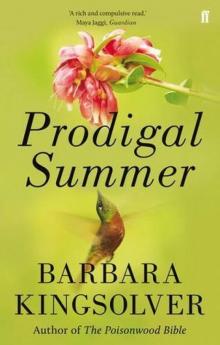 Prodigal Summer: A Novel
Prodigal Summer: A Novel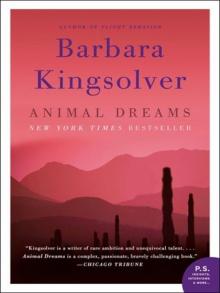 Animal Dreams: A Novel
Animal Dreams: A Novel The Poisonwood Bible
The Poisonwood Bible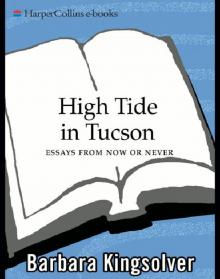 High Tide in Tucson
High Tide in Tucson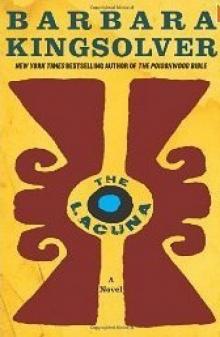 The Lacuna
The Lacuna The Bean Trees
The Bean Trees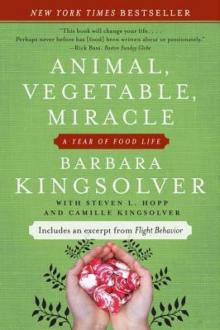 Animal, Vegetable, Miracle: A Year of Food Life
Animal, Vegetable, Miracle: A Year of Food Life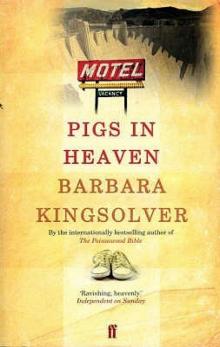 Pigs in Heaven
Pigs in Heaven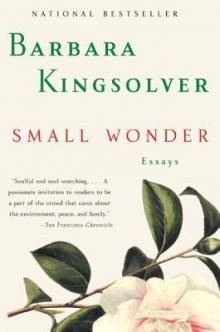 Small Wonder
Small Wonder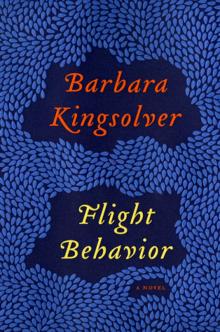 Flight Behavior
Flight Behavior Homeland and Other Stories
Homeland and Other Stories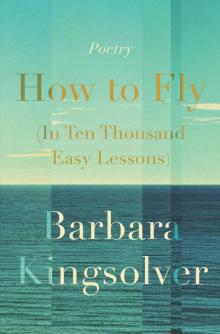 How to Fly (In Ten Thousand Easy Lessons)
How to Fly (In Ten Thousand Easy Lessons) Unsheltered
Unsheltered Animal Dreams
Animal Dreams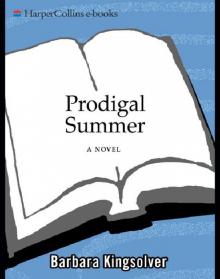 Prodigal Summer
Prodigal Summer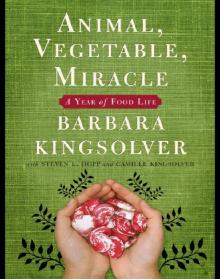 Animal, Vegetable, Miracle
Animal, Vegetable, Miracle